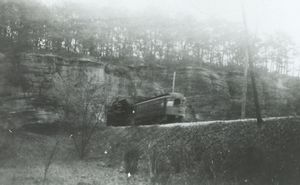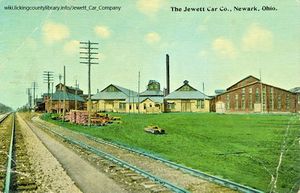Interurban
Newark-Granville Line
The use of electric rail locally in Licking County was the brainchild of a Pittsburgh man named R. A. Cunningham. Cunningham collected a group of local investors and set out to build a line that would run from Newark to Granville. Construction began in 1888 and the line was completed in December 21, 1889. The first electric car ran from Newark to Granville on October 4, 1890, inaugurating what may have been at the time, the longest stretch of electric road in the world, the Newark-Granville electric line may have been [2]
Not only did Licking County enjoy an early electric car line,it was also a production center for the interurban cars; the Jewett Car Company, which relocated to Newark in 1900, specialized in the manufacture of elevated, subway, and interurban cars. The company thrived in the early 1900s, expanding and employing up to 400 workers and supplied cars not only to the interurban lines of Ohio but to the elevated rails of Chicago and New York's subways. [3]Electric rail lines proliferated in central Ohio in the early twentieth century with lines connecting the Newark-Granville line to Zanesville, Buckeye lake, Columbus, and beyond. The line companies became consolidated under the Ohio Electric Railway Company in 1906. [4]
After enjoying tremendous growth in the first decades of the 20th century, the interurban lines went into decline in the 1920s. The Jewett Car Company was an early victim, closing down its production in 1919 as demand for new cars cratered. Devastated by the popularity of the automobile and hampered by the economic catastrophe of the stock market crash of 1929 and the ensuing Great Depression, most lines saw severe drops in use after 1930. By 1960 only a few cities preserved the electric rail cars in use, most famously in Chicago's South Shore Line. [5]
A restored Jewett interurban car can be seen in Newark today; The Works Center for History, Art and Technology in Newark houses the railcar in its display on the local interurban rail. Visitors can climb aboard and imagine what it was like to ride the electric rail in the early nineteenth century. [6]
For more information see:
Lawrence Brough and James Graebner. From Small Town to Downtown: A History of the Jewett Car Company 1893-1919. Bloomington, IN: Indiana University Press, 2004.
William Middleton. The Interurban Era. Milwaukee: Kalmbach, 1961.
J.G.
References
- ↑ Middleton, W., The Interurban Era, (1961), 12-13
- ↑ Brister, E., Centennial History of the City of Newark and Licking County, Ohio, (1909), 198-199. Brister makes the claim of the longest stretch of electric rail in the world in 1890, but this cannot be corroborated.
- ↑ Photographic History of Newark and Licking County, (1904)
- ↑ Brister, E., Centennial History of the City of Newark and Licking County, Ohio, (1909), 200
- ↑ Middleton, W., The Interurban Era, (1961), 400-410
- ↑ https://attheworks.org/experience-history/


